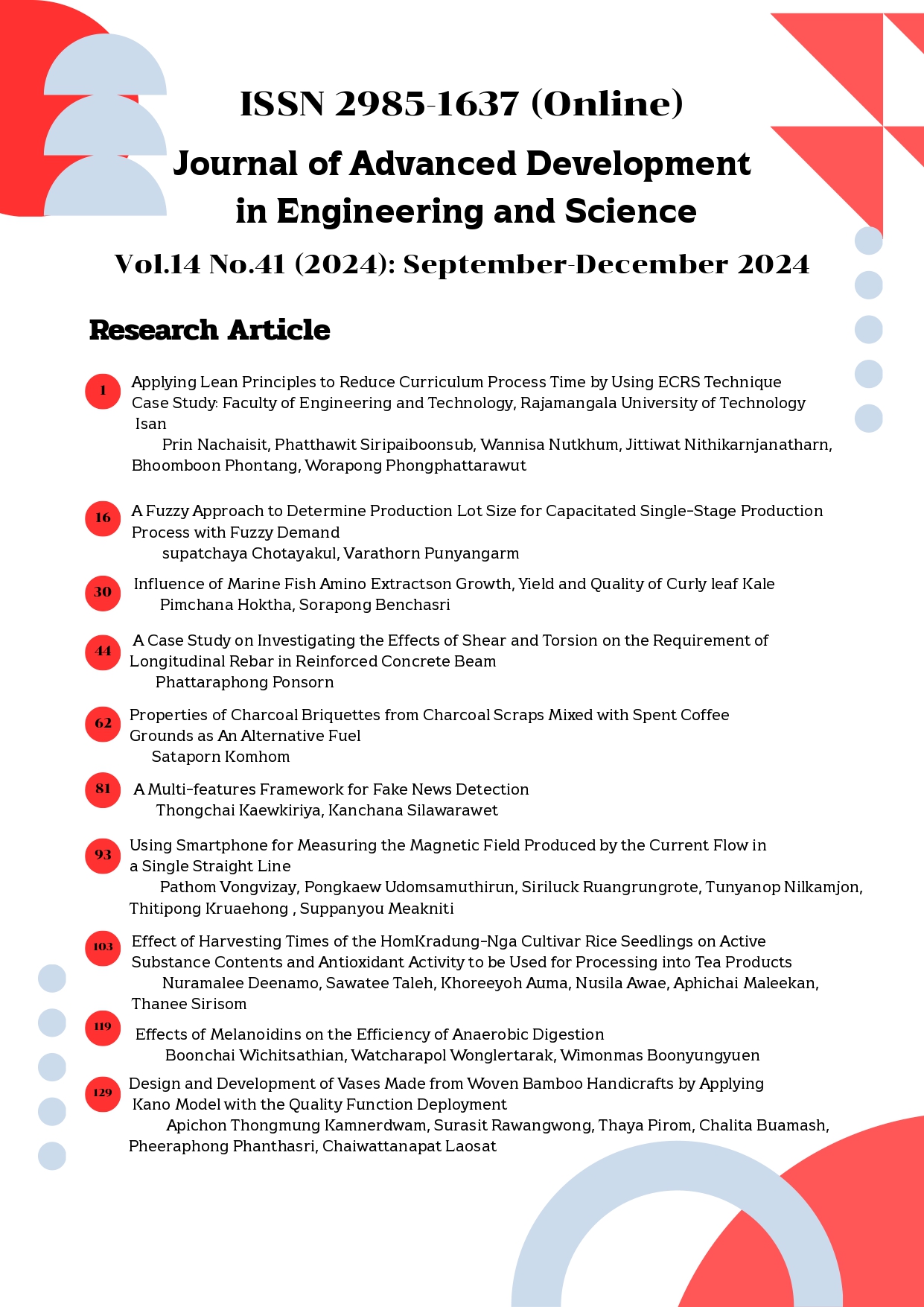อิทธิพลของสารสกัดอะมิโนปลาทะเลต่อการเจริญเติบโต ผลผลิตและคุณภาพของเคลใบหยิก
Main Article Content
บทคัดย่อ
วัตถุประสงค์ของการวิจัยเพื่อเปรียบเทียบอิทธิพลของสารสกัดอะมิโนปลาทะเลต่อการเจริญเติบโตผลผลิต องค์ประกอบผลผลิต และคุณภาพเคลใบหยิก โดยมีระยะเวลาในการทดลองตั้งแต่เดือนมกราคมถึงสิงหาคม พ.ศ. 2566 ณ มหาวิทยาลัยทักษิณ วางแผนการทดลองแบบสุ่มสมบูรณ์ (Completely RandomizedDesign; CRD) จำนวน 4 ซ้ำ ประกอบด้วย 5 ทรีตเมนต์คือการใช้ระดับความเข้มข้นต่างกันของสารสกัดอะมิโนปลาทะเลที่ฉีดพ่นทางใบสัปดาห์ละ 2 ครั้งหลังปลูก ได้แก่ 0.00 (ควบคุม), 1.50, 3.00, 4.50 และ 6.00 มิลลิลิตร/ลิตร ผลการวิจัยพบว่าสารสกัดอะมิโนปลาทะเลระดับความเข้มข้นต่างกัน มีอิทธิพลต่อการเจริญเติบโตของเคลได้แก่ ความสูงต้น ความกว้างใบ ความยาวใบ ความกว้างทรงพุ่ม ความกว้างต้น และความยาวต้นแตกต่างกันทางสถิติ โดยระดับความเข้มข้น 3.00 มิลลิลิตร/ลิตร ให้ค่าเฉลี่ยความสูงต้นและความยาวต้นสูงกว่าระดับความเข้มข้นอื่นๆ คือ 43.02 เซนติเมตร/ต้น และ 17.21 เซนติเมตร/ต้น ตามลำดับ ขณะที่ระดับความเข้มข้น 1.50 มิลลิลิตร/ลิตร ให้ค่าเฉลี่ยความกว้างใบ ความยาวใบ ความกว้างทรงพุ่มและความกว้างต้นสูงกว่าระดับความเข้มข้นอื่นๆ คือ 17.50 เซนติเมตร/ใบ, 36.75 เซนติเมตร/ใบ, 62.11 เซนติเมตร/พุ่ม และ 3.79เซนติเมตร/ต้น ตามลำดับ นอกจากนี้ระดับความเข้มข้นต่างกันของสารสกัดอะมิโนปลาทะเลมีอิทธิพลต่อองค์ประกอบผลผลิตและผลผลิตของเคลแตกต่างกันทางสถิติ โดยระดับความเข้มข้น 3.00 มิลลิลิตร/ลิตร ให้ค่าเฉลี่ยน้ำหนักใบและจำนวนใบ/ต้น สูงกว่าระดับความเข้มข้นอื่น ๆ คือเฉลี่ย 12.66 กรัม/ใบ และ 25.33 ใบ/ต้น ตามลำดับ และให้ค่าเฉลี่ยน้ำหนักใบต่อต้นสูงสุดเฉลี่ย 320.68 กรัม/ต้น แต่ไม่แตกต่างกันทางสถิติกับระดับความเข้มข้น 1.50, 4.50 และ 6.00 มิลลิลิตร/ลิตร ให้มีเฉลี่ย 306.76, 298.18 และ 273.79 กรัม/ต้น ตามลำดับ ขณะที่แตกต่างกันทางสถิติกับระดับความเข้มข้น 0.00 มิลลิลิตร/ลิตรที่มีค่าเฉลี่ยน้ำหนักใบต่ำที่สุดเพียง 210.61 กรัม/ต้น
Article Details

อนุญาตภายใต้เงื่อนไข Creative Commons Attribution-NonCommercial-NoDerivatives 4.0 International License.
เนื้อหาและข้อมูลในบทความที่ลงตีพิมพ์ใน Journal of Advanced Development in Engineering and Science ถือเป็นข้อคิดเห็นและความรับผิดชอบของผู้เขียนบทความโดยตรง ซึ่งกองบรรณาธิการวารสารไม่จำเป็นต้องเห็นด้วยหรือร่วมรับผิดชอบใดๆ
บทความ ข้อมูล เนื้อหา ฯลฯ ที่ได้รับการตีพิมพ์ในJournal of Advanced Development in Engineering and Science ถือเป็นลิขสิทธิ์ของ Journal of Advanced Development in Engineering and Science หากบุคคลหรือหน่วยงานใดต้องการนำทั้งหมดหรือส่วนหนึ่งส่วนใดไปเผยแพร่ต่อหรือเพื่อกระทำการใดๆ จะต้องได้รับอนุญาตเป็นลายลักษณ์อักษรจาก Journal of Advanced Development in Engineering and Scienceก่อนเท่านั้น
เอกสารอ้างอิง
Ortega-garcía, F. & Peragón, J. (2009). The response of phenylalanine ammonia-lyase, polyphenol oxidase and phenols to cold stress in the olive tree (Oleaeuropaea L. cv. Picual). Journal of the Science of Food and Agriculture, 89(9), 1565–1573.
Ortega-hernández, E. et al. (2021). Improving the health-benefits of kales (Brassica oleracea L. var. acephala DC) through the application of controlled abiotic stresses: A Review. Plants, 10(12), 2629.
Walsh, R. P. et al. (2015). Variation in carotenoid content of kale and other vegetables: a review of pre- and post-harvest effects. Journal of Agricultural and Food Chemistry, 63(44), 9677−9682.
Juthong, T. & Benchasri, S. (2022) Optimum temperature for drying process of okra fruit. Journal of Vocational Education in Agricultureม 6(2), 47-58. (in Thai)
Satheesh, N. & Fanta S. W. (2020) Kale: Review on nutritional composition, bioactive compounds, anti-nutritional factors, health beneficial properties and value-added products. Cogent Food & Agriculture, 6(1), 1811048
Kim, S. Y. et al. (2008). Kale juice improves coronary artery disease risk factors in hypercholesterolemic men. Biomedical and Environmental Sciences, 21(2), 91–97.
Mendoza, M. D. L. N. R et al. (2021) Field production of kale (Brassica Oleracea var. Acephala) with different nutrition sources. Agro Productividad, 10.32854/agrop.v14i10.1954.
Khalid, W. et al. (2021). Kale (Brassica oleraceavar. sabellica) as miracle food with specialreference to therapeutic and nutraceuticals perspective. Food Science & Nutrition, 10(9), 3175.
Benchasri, S. et al. (2022). Efficacy of marine fish amino acid on growth and qualitative color of okra in summer season of Thailand. In The 33th TSU Conference 2022 “Glocalization of Research and Innovation” (p.637-642). 22-23 August, 2022, Nakonsitammarat, Thailand.
Baqir, H. A. & Naqeeb, M. A. S. (2019). Effect of some amino acids on tillering and yield of three bread wheat cultuvars. Iraqi Journal of Agricultural Sciences, 50(Special Issue), 20-30.
Gauthankar, M., et al. (2021). Comparative assessment of amino acids composition in two types of marine fish silage. Scientific report, 11, 15235.
Johari, N. S., et al. (2020). Effects of fish amino acid (Faa) application on growth and development of okra (Abelmoschus Esculentus) at different sampling times. Journal of vocational education studies, 3(2), 128-135.
Krishnamoorthy R. et al.(2019). Impact of farm-made liquid organic nutrients jevamirtham and fish amino acid on growth and nutritional status in different season of Abelmoschus esculentus-a self-sustainable field trial. Organic Agriculture, 9, 65–79.
Suwanaruang, T. (2017). Total carotenoid content in fresh vegetables. Rajabhat Agriculture Journal, 16(2), 40-45. (in Thai)
Kundu, P., et al. (2016). Feeding impact of the vegetable mite, tetranychus neocaledonicus André (Acari: Tetranychidae) on Mentha rotundifolia L. International Journal of Recent Scientific Research, 7(4), 10406-10409.
Tangthanantorn, J. et al. (2021). Development of fresh and dried noodle products with high resistant starch content from banana flour. Food Science and Technology, 42, e68720.
Osotsapar, Y. (2014). Using biological accelerators to promote fo plant growth. Journal of Soil and Fertilizer, 36(1), 27-54. (in Thai)
Maini, P. (2006). The experience of the first biostimulant, based on amino acids and peptides: a short retrospective review on the laboratory researches and the practical results. Fertilitas Agrorum, 1, 29-43.
Hildebrandt, T. M., et al. (2015). Amino acid catabolism in plants. Molecular Plant, 8(11), 1563-1579.
Phayungtham A. et al. (2012). Influences of amino acid chelate foliar fertilizer on growth and seed quality of hybrid tomato seeds. KhonKaen Agriculture Journal, 40, 167-178. (in Thai)
Benchasri, S. (2023). Effect of marine fish amino acid on yield of okra production. Journal of Vocational Education in Agriculture, 7(2), 115-126. (in Thai)
Priyanka, B., et al. (2019). Foliar application of fish amino acid and egg amino acid to improve the physiological parameters of rice. International Journal of Current Microbiology and Applied Sciences, 8(2), 3005-3009.
Kumar, V, et al. (2018). Organic sources use of amino acids based biostimulants and irrigation schedule on yield: Water use efficiency relationship on potato tuber. Journal of Pharmacognosy and Phytochemistry. 7(1), 1255-1259.

